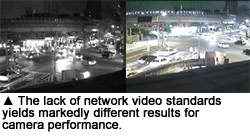a&s Taiwan, a sister publication of a&s, recently conducted a test of network cameras. Editorial consultant Alf Chang, a former installer, examined nine cameras to see if they delivered real-life results. All cameras were tested for performance, ease of use and integration.
a&s Taiwan, a sister publication of a&s, recently conducted a test of network cameras. Editorial consultant Alf Chang, a former installer, examined nine cameras to see if they delivered real-life results. All cameras were tested for performance, ease of use and integration.
Network cameras are one of the hottest technological developments in security, with forecasts predicting widespread adoption in the next two years. In reality, uptake is less than 20 percent, hindered by a lack of IT knowledge.
To provide users and installers with more information, the A&S network camera shootout sought real-world examples about camera performance. The cameras were mounted at a major urban intersection and in a controlled indoor environment. All cameras used the same lens for fairness. The test was not intended to be a competition, as different applications require different hardware.
Image Quality
Installers and users frequently ask for standard resolution or the best compression, but there is more than one solution. As resolution is affected by compression, an image at a set resolution will display differently when compressed by different algorithms. Whether H.264, M-JPEG or MPEG-4 is used, each vendor has proprietary codecs, so the same image will look slightly different.
More pixels do not necessarily translate into better images. While megapixel cameras are suited for large areas, our tests found megapixel CMOS image sensors performed poorly for moving objects, with jagged edges and image lag. Network cameras at VGA (640 x 480) or D1 (720 x 480) resolution showed better detail for moving images, although they a smaller field of view (FOV) compared to megapixel cameras.
The test showed good clarity for CMOS sensors at 700 TVL, or 1280 by 1024 pixels. However, most of the cameras at 1600 x 1200 or 1980 x 1080 resolution transmitted images at 15 fps. This rate may drop in practical use due to bandwidth constraints and file size, resulting in image lag. From our testing, megapixel cameras perform best at about 1280 x 720 (720P), transmitting clear and stable images at more than 15 fps.
True Colors
Color hue and saturation was tested with a 24-shade color plate. Each camera took a sample image at its default setting, with the same ambient illumination.
The tested CMOS cameras had fainter color, compared to the deeper hues taken by the CCD ones. As the CMOS images were paler, color contrast was less noticeable. For low-light applications, such as nighttime LPR, CCD-based network cameras offer better contrast.
Color correction was tested, with some cameras delivering consistent auto white balance (AWB) regardless of light changes. Accurate AWB means realistic color capture for better identification.
Real-Time Footage
The network cameras were tested for transmission speed, by setting bandwidth at 4 megabytes per second and clocking image transfer time. VGA images in H.264 or MPEG-4 at 30 fps maintained speeds of about 250 milliseconds (ms). Larger 720P images in M-JPEG at 15 fps took longer at 500 to 1,250 ms, resulting in image lag.
CMOS Sees in the Dark
A&S observed how the network cameras managed nighttime images. Background  illumination was set to 0.1 lux, to test ICR-equipped cameras for sensitivity and noise suppression. The cameras with IR-cut filters were observed for sensitivity to illumination.
illumination was set to 0.1 lux, to test ICR-equipped cameras for sensitivity and noise suppression. The cameras with IR-cut filters were observed for sensitivity to illumination.
Apart from default settings, the cameras were tested for image correction, including exposure, electronic shutter, day/night and automatic gain control. These tests looked at how well the cameras displayed color even at night.
The tests showed marked improvement for CMOS performance, as even non-low-light models displaying decent images with fixed illumination.
CMOS has overcome previous sensitivity issues, making it viable for nighttime surveillance.
The tested CCD models displayed good nighttime detail and noise suppression.
Ease of Use
Each camera was examined for practicality. For starters, port placement must be accessible. Some cameras required unplugging cables to reach a port, which is not ergonomic. Each port should be clearly marked, as poor design could translate into delays of network downtime or fruitless manual labor for installers.
Service ports are missing from most network cameras, which provide real-time focus correction. Without them, installers need to manually adjust cameras without a display or juggle a notebook while tweaking the lens. Adding this functionality improves installation quality and gives vendors a competitive edge.
Components
Lenses must fit the camera, as our test showed megapixel cameras require megapixel lenses. The 16:9 images had warped corners without a proper lens, resulting in loss of detail.
Heat dissipation is critical for network cameras, as their processors run hotter. If it is not considered during design, poor heat dissipation may crash the camera.
Temporary backup storage, such as SD cards, provides images even if the network goes down. Onboard storage media also makes data portable.
Integration
To emphasize real-world use, the cameras were tested with Microsoft Internet Explorer (IE) rather than their respective VMS platforms. While some cameras had more IE functions than others, they covered basic user needs.
However, industry fragmentation was evident from how video backup and snapshot functions were performed. Playback software ranged from VLC, QuickTime Player, Real Player to Window Media Player, with an equally wide range of storage formats. This is difficult for users to integrate.

Some vendors address this by using an NVR for storage or designing a VMS. However, NVRs have interoperability issues with third-party network cameras.
Increased IE functionality improves integration. If the network camera allows for an IE preview along with onscreen adjustment features, installers can adjust images directly, instead of toggling between the browser view and the camera's management platform.
Camera providers have already improved software performance, with VMS ready for Vista or even Windows 7. However, high definition video places higher demands on workstations, servers and computing power.
More importantly, 720P resolution is poised to become a high resolution standard. From a solutions standpoint, offering a megapixel network camera includes upgrading back-end displays and storage. Vendors must consider user needs when developing cameras. If deploying megapixel cameras requires a complete computing upgrade, the migration to IP faces many roadblocks.